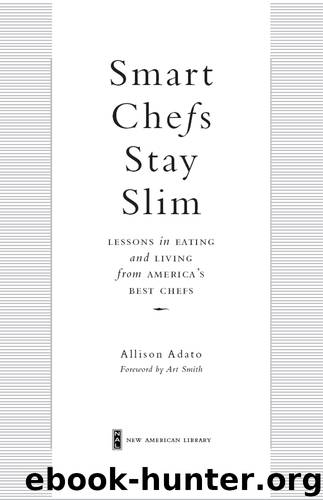Smart Chefs Stay Slim by Allison Adato

Author:Allison Adato [Adato, Allison]
Language: eng
Format: epub
ISBN: 9781101580080
Publisher: Penguin Group US
Published: 2012-04-02T16:00:00+00:00
Lesson 51: They think about portion size
Chefs are customers as well as providers, so they consider this question from both sides of the plate. Colicchio’s distaste for being served a too-big portion when he goes out influenced him when he was designing a menu for the restaurant he launched in 2010, Colicchio & Sons. “I made the portions purposely small. But because we serve expensive ingredients, and still have to charge a good amount of money for them, I got ripped apart. People complained, ‘These portions are so small!’ But if you eat an appetizer, entrée, and dessert, I can’t believe you’re not full.” Nonetheless, he took the hint and made the portions slightly bigger. “People may skip dessert, but they want large portions,” he noticed. “Then they won’t eat the large portion.”
I wonder why this is. Is it a problem stemming from the same root as the inflation of clothing sizes at the mall (what once was a ten is now an eight and so on)? Do diners feel somehow more virtuous if they can leave something behind on their plate, despite actually consuming a lot of food? Do we need a portion so big that we can sate ourselves and still appear to those across the table as if we are too dainty to finish an entrée?
Colicchio isn’t sure either, though he perceives this as a uniquely modern American paradox. “Customers want to see that big portion, but then they get full or bored with it. It’s the complete opposite of people who grew up during the Depression, or people in Europe during the war who ate everything on their plate because food was so scarce. In Europe, when I worked there, the chef always wanted to see the plates when they came back, and if they weren’t finished, that meant something was wrong with the dish. Over there, you never heard, ‘I’m just full.’”
Even chefs who are sensitive to this problem are probably serving too much food, because customers demand it. So when they eat out, they know that they likely won’t be eating the whole thing; they can see when a portion is too big. It’s worth taking the time to learn what a reasonable portion size—six to eight ounces of protein, about half a cup of pasta—looks like on a plate. Then you will be able to eat small portions of virtually everything you love.
For a variety of reasons, you won’t be able to convince the waiter or the chef to serve portions of that reduced size. So take the advice of Ming Tsai: “The best thing to do is don’t finish the plate. When you stop being hungry, stop eating.”
Rick Bayless concurs on this point. He frequently orders both an appetizer and an entrée when he goes out with his wife and restaurant partner, Deann, and he loves sweets. On the job, he enjoys major multicourse “research” meals when he’s traveling in Mexico for his PBS show. How does all of this not add up to obesity? It’s an equation that can confound newer members of his TV crew.
Download
This site does not store any files on its server. We only index and link to content provided by other sites. Please contact the content providers to delete copyright contents if any and email us, we'll remove relevant links or contents immediately.
How to Be a Bawse: A Guide to Conquering Life by Lilly Singh(7382)
Deep Work by Cal Newport(6877)
The Longevity Diet by Valter Longo(5017)
The Fat Loss Plan by Joe Wicks(4845)
The Four-Pack Revolution by Chael Sonnen & Ryan Parsons(3932)
The Ultimate Bodybuilding Cookbook by Kendall Lou Schmidt(3884)
The French Women Don't Get Fat Cookbook by Mireille Guiliano(3604)
Super Food Family Classics by Jamie Oliver(3366)
Not a Diet Book by James Smith(3335)
Factfulness_Ten Reasons We're Wrong About the World_and Why Things Are Better Than You Think by Hans Rosling(3197)
Turn Up Your Fat Burn! by Alyssa Shaffer(3182)
Self-Esteem by Matthew McKay & Patrick Fanning(3091)
Tom Kerridge's Dopamine Diet: My low-carb, stay-happy way to lose weight by Kerridge Tom(3063)
Body Love by Kelly LeVeque(3012)
The Unbecoming of Mara Dyer by Michelle Hodkin(2998)
The Fat Chance Cookbook by Robert H. Lustig(2791)
Tone Your Tummy Type by Denise Austin(2785)
LL Cool J's Platinum 360 Diet and Lifestyle by LL Cool J(2685)
Men's Health Best by Men's Health Magazine(2551)
